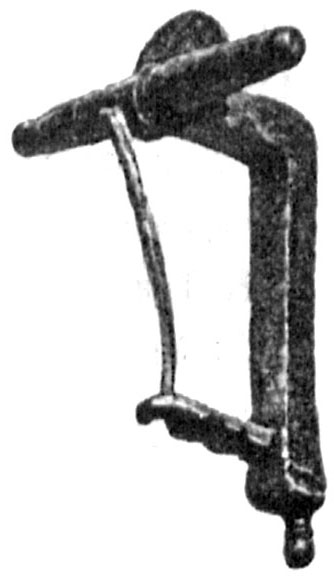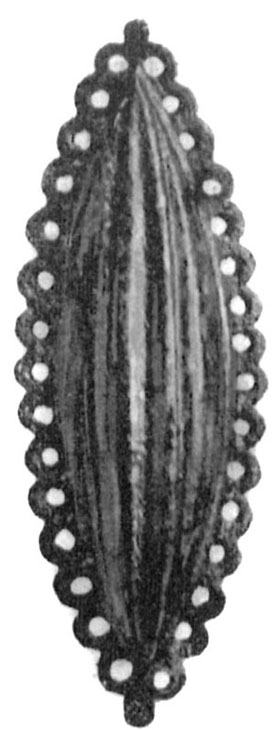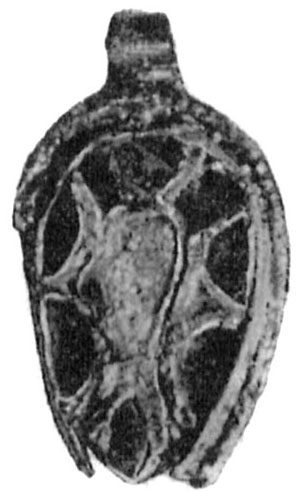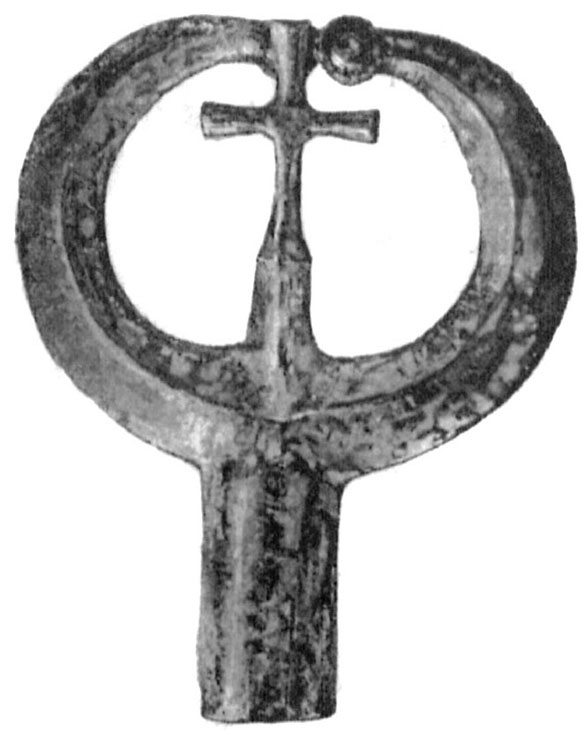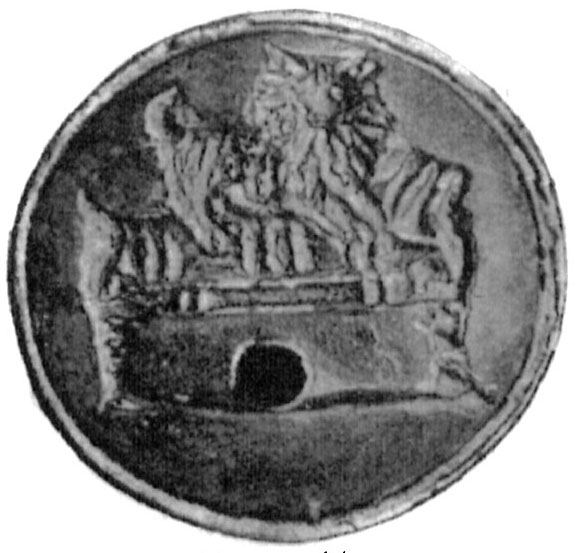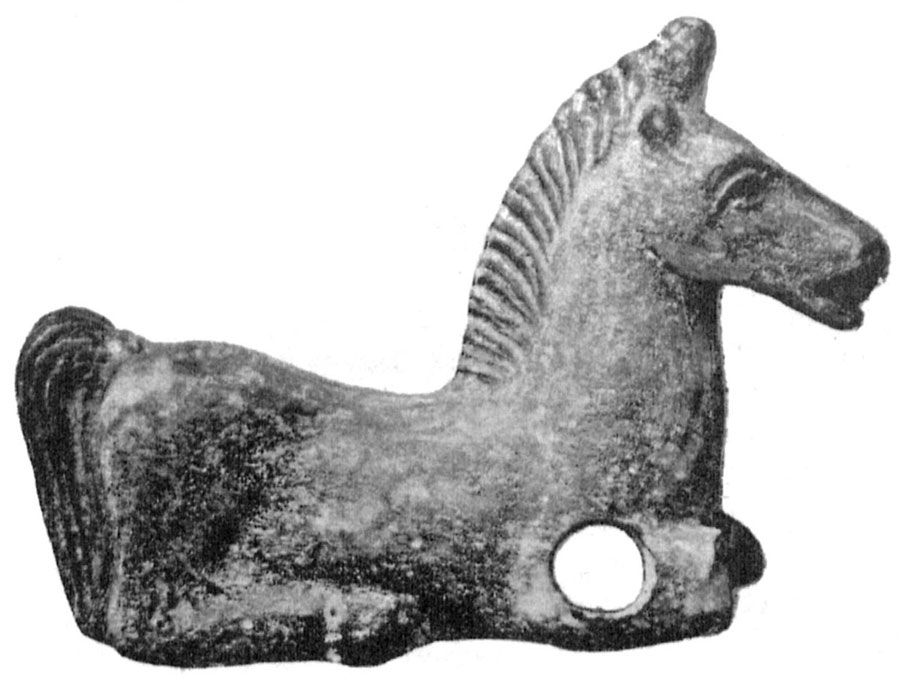 |
 |
 |
|
||
| main :: biography :: texts :: manuscripts :: photographs :: drawings :: squeezes :: publications :: about | ||
|
1893 REPORT OF THE SUPERVISOR OVER THE EXCAVATIONS IN CHERSONESOS I. Excavations at the north side of the building that is intended for the warehouse of antiquities
In order to protect the north wall of the museum from dampness and to make communication between watchman's room and the old dug-out fit for storehouse of tools, there was need to remove considerable ground mound, about 12 sazhenes long, and to make dry buttress wall. In course of these works, water-absorption well was uncovered; it was cut into bedrock, had 1 ¾ arch<ines> in diameter and 7 arch<ines> in depth, and reached the sea water. There was wall of a house in the upper city going from west to east above the well, which was blocked with stone and soil. A fragment of marble slab with part of Greek inscription (11 letters in three lines) was uncovered between of the stones removed from the well. A splinter of marble pedestal, 9" х 9" х 2", with a part of slot for the statue's feet, was uncovered in between of the dug-out and the north-west corner of the museum, almost on the surface of the ground. This splinter constituted top left corner of the monument and preserved 16 letters of the beginning of the first and second lines of the Greek inscription. If this inscription remains, it would occupy one of the prominent positions amidst epigraphic monuments of Chersonesos, because it is dedicated to the Bosporan king Aspourgos, who received his title of the king from Tiberius in AD 14-15, and would shed some light on the period when Chersonesos was subjugated to the Bosporan Kingdom. There is a fragment of marble slab, 1 ½" wide, with part of two letters of Latin inscriptions found in the same area.
Besides these fragments of epigraphic monuments, the following antiquities were discovered there: bottom left corner of smoothly polished slate plate with a part of very carefully carved relief image of Savior sitting on throne
(s<ee> fig. 32)
; damaged bronze cross; 20 shards of glazed earthenware pottery; throwing stone; bronze button in the form of small closed bell; earthenware ball; 3 earthenware sinkers in the form of truncated pyramids; scarab-shaped pendant of blue glass; elongated bead of blue glass; grinding stone, 1 ½" long, rounded; shard of brown ceramic cup with mould image of procumbent vine and the birds sitting on it; amphora handle with Greek inscription and image of eagle sitting on dolphin; 2 plain earthenware circles with hole in the middle; bronze ring; fragment of deer's horn; wild goat's horn; wild boar's tusk; bone end-piece, 2" long, rounded, with cuts and hole in its cross part; fragment of roof tile with part of Byzantine inscription, probably, with the name of Theodore reading from the right (no Byzantine roof tiles with names have been found before); 2 silver oriental coins; bronze Byzantine coin; 34 bronze coins of Byzantine Chersonesos: of Basil I - 8 specimens, of Romanus I - 22 specimens, and of Romanus II - 4 specimens.
II. In the east area of the ancient city site, on the northern seashore, to the left from Uvarov basilica
In the year under report, the final investigation of minor basilica, which had been discovered in 1877 by the excavations of the Imperial Odessa Society of History and Antiquities, was finished. Two more stone pillars were uncovered on the western side; this way, there are 6 pillars discovered in this basilica that had been used as foundations for columns. The finds, like in previous year, belong to two periods of Chersonesos history: Greco-Latin and Byzantine, depending on the depth of cultural layer, which in some places reaches 1 sazhene. Finds of the I period are: 9 amphora handles with Greek names: 5 from Chersonesos (?), 2 from Thasos and 2 from unknown colonies; fragment of roof tile with Greek inscription; 14 earthenware sinkers for fishing nets in the form of truncated pyramids: one with a letter, 3 with images of heads of bed preservation, and 10 plain; 43 shards of black slip pottery: 6 with drawings, one with scratched name, and 36 without drawings nor initials; 2 damaged black slip lamps; damaged black slip vessel; 9 glass beads; bronze arrowhead; 2 throwing stones; piece of wall plaster painted in red color; straight bronze key; bronze leg for casket in the form of lion's paw; lower fragment of glass bottle with traces of relief decoration in red, yellow and milky colors; minor bronze coin of Olbia (s<ee> Burachkov's Sbornik materialov [Collected materials], plate IV, no. 54); minor bronze coin of Cersonesos (Burachkov, <Op. cit.>, pl. XV, no. 71); 10 bronze, extremely bad preserved, coins of the Roman emperors.
Finds of the II period are: fragment of thin and small marble column; medium-size fragment of marble column; 3,326 fragments of glass many-colored mosaics; 6 splinters of glass bracelets; 6 round glasses for finger-rings; 6 earthenware sinkers for fishing nets in the form of plates with hole on either end and groove which probably prevent the cord from friction; sinker for fishing nets in the form of lead ring; shard of marble mortar; 3 earthenware circles, flat and with holes (similar circles, of bone, are common, though their purpose is still unknown); earthenware ball (it is undoubtedly a toy, because some of such balls discovered earlier were glued together of two halves and fine stones were put within); bone checker; 4 bronze buttons in the form of small closed bells; 2 bronze thimbles; 4 shards of glazed earthenware pottery; bronze coin of Leo I; 2 big bronze Byzantine coins of extremely bad preservation; 93 bronze coins of Byzantine Chersonesos: of Justinian I - 1 specimen; of Michael III and Basil I - 1 specimen, of Maurice (Burachkov, <Op. cit.>, pl. XVII, 125 and 128) - 2 specimens; of the same emperor, of medium size, evidently unpublished - 1 specimen; of Basil I - 16 specimens; of Basil I and Constantine IX - 3 specimens; of Leo VI - 2 specimens; of Leo VI and Alexander - 1 specimen; of Romanus I - 40 specimens; of Constantine Х - 6 specimens; of Romanus II - 6 specimens; of Constantine Х and Romanus II - 6 specimens; of Nicephorus Phocas - 3 specimens, and of Basil II - 5 specimens.
III. On the north seashore close to monastery cemetery
After the Imperial Archaeological Commission's suggestion to excavate in the areas, which may, by this or that reason, be covered with buildings in the nearest future for military or monastery's purposes, reconnaissances were organized in the area of the north seashore that adjoined the east side of the monastery cemetery, as it became known that the monastery was going to encircle the cemetery with a wall. The excavation made in 1889 on the west side reached the very cemetery, which, on the north side, is divided from the sea by narrow strip of steep coast. Irrespective of the above reason, the excavations were desirable there to connect with the coastal excavations of 1889, 1891 and 1892; it is possible to continue these excavations in 1894 along the shore till they meet 1888 excavation. Excavations in this area of the ancient city site generally are of great interest because they have discovered, on a considerable depth reaching 2 sazhenes, basilica, two altarless churches, and big building with basement that survived. Besides that, the excavations gave a number of interesting finds. There were two fragments of marble cornice, each 4 ¼ arch<ines> long and 1 arch<ines> and 5 versh<oks> wide, laying on the floor of big basilica; one is intact, another is broken into three pieces. The whole cornice is 8 ½ archines long. There is stone box, 22 ½" long, 11 ½" wide, 11 ½" high and 8" deep, with sliding board from one side and covered with slab from above, which was uncovered in the basilica chancel. This box obviously housed a reliquary. There, inside the basilica, amidst a number of marble fragments that will be listed below, there were 6 epigraphic monuments, namely: 1) marble slab, 19" х 18 ½" х 4", with bottom part missing, with Greek inscription (622 letters in 20 lines) of excellent preservation; 2) marble slab, 17-22" х 15" х 3", the fragments on top, bottom and right of it missing; plain border survived on the left; with Greek, well-preserved inscription (364 letters in 22 lines). The bottom fragment of this slab with part of the border and inscription (54 letters in 6 lines) was also found; 3) marble slab, 17" х 21" х 3", intact, with Greek inscription carved in small characters and carelessly (103 letters in 6 lines); 4) fragment of marble slab, 3-4" х 5 х 3 ½", with part of Greek inscription (8 letters in 2 lines); 5) fragment of marble slab, 12" х 6" х 1 ½", with part of Byzantine inscription (12 letters in 2 lines). There is part of relief cross in the middle; on top and to the right there are part of 2" wide border with roughly carved wreath and rosette above the cross; 6) fragment of cornice, 11" long, with part of cross with beginning of inscription of 13 letters in one line. The part of the cornice that projects forwards and has an inscription is 1 ½" wide. The following marble parts were found within the basilica:
The fourteen tombs in the basilica and altarless church which is most close to it contained, apart of multitude of bones: 5 glass bracelets; 8 fragments of glass bracelets; 2 child's bracelets of bronze; 3 finger-rings, of bronze, plain; 3 belt buckles of bronze; 8 bronze buttons in the form of small closed bells; big bronze thimble. The corner, projecting forward altarless church had the floor covered with clear fine sand. This altarless church was separated from the nearest building by lane 2 sazh<enes> wide. In this lane, there were two pear-shaped cisterns, carved into bedrock and cemented; the first was 3 arch<ines> and 2 ver<shoks> deep, 1 arch<ine> in diameter on top and 3 arch<ines> and 2 ver<shoks> at the bottom, with the floor beautifully paved with bricks, and the second was 5 arch<ines> deep, 1 arch<ine> and 4 ver<shoks> in diameter on top and 3 arch<ines> at the bottom. The big house in interested because of its terrace with traces of marble facing and basement with round brick kiln. In the second from the west room, there were 192 bronze coins, accumulated on the floor, of Chersonesos of the emperor Romanus I, of medium size, all of the same type. In the street drain canal constructed of stone slabs, on the depth of 3 ¼ arch<ines> from the ground surface, there was hen's nest with six eggs in it, one of which was absolutely intact, two with inconsiderable damages and three were crushed by the soil that penetrated into the canal. There are the following antiquities found when making excavations in the given area, apart from the above-described epigraphic monuments, stone box for reliquary, worked marbles from the basilica and 192 coins of Romanus I:
Finds of the I period are: 10 amphora handles with Greek names (one from Chersonesos (?), one from Thasos, two from Rhodes, three with image of eagle on dolphin and three from unknown colonies); 3 fragments of roof tiles with Greek names; 3 earthenware sinkers for fishing nets in the form of truncated pyramids, with letters; big sinker of the same form, with relief image of woman's face facing right, within oval depression; 18 plain sinkers of the same form; black slip earthenware lamp, damaged, of excellent workmanship, covered with slip inside as well; the same, damaged black slip earthenware lamp with long round foot; fragment of black slip lamp of a special form, with hole in the middle for putting it on a stand; 3 shards of black slip lamps; 2 shards of black slip ware with drawings; 6 shards of black slip ware with initials; shard of black slip vessel with the name of Apollodoros scratched on it; 40 shards of black slip ware without drawings or initials; fragment of neck of black slip krater; fragment of black slip cup decorated with molded shells; shard of plate, of recd ceramic, with molded image of man's head, some tools, man running to the left and antelope running to the right (s<ee> fig. 33); leg, of high artistic quality, from terracotta statuette of a man (Heracles?); terracotta foot of right leg, 4 ½" long, chopped off a statuette; 6 shards of terracotta statuettes without extremities; small bronze hollow ram's head of rough workmanship; bronze paw of rough workmanship; lamp of red ceramic, with relief image of horse; 6 plain earthenware lamps ; 14 glass beads; 5 beads of multicolored paste; big bead of jet; bead of rock crystal; piece of red paint; bronze folding key; fragment of bronze straight key; fragment of hammer of black polished stone which was used, according to worn-off edges, as polishing tool; jet axe-shaped pendant; 2 bronze dagger-shaped pendants (these might be not pendants but clasps), 3 fine grinding stones with holes; bone ring of unknown purpose; 11 throwing stones; stone of hard rock, rounded, 4 ½" х 3 ½' х 3", with fine circular holes (1 ¾" in diameter) in the middle of its 4 long sides, which could be a weapon for hand-to-hand fight; 6 lead votive symbols: bull's skull and head of Hermios wearing petasos (2), bull's skull and dolphin (3), bull's skull and unclear monogram; 9 bronze coins of autonomous Chersonesos (Burachkov, Sbornik materialov [Collected materials], pl. XIV, no. 27-1; no. 29-1; no. 33-1; pl. XV, no. 55-1; no. 71- 4 and no. 73-1); 12 bronze coins of Chersonesos of the Roman period (Burachkov, <Op. cit.>, pl. XVI, no. 91-1; no. 92-1; no. 95-1; no. 96-1; no. 98-1; no. 101-1; no. 102-2; no. 103-1; no. 108-1; no. 111-1 and no. 117-1); 2 bronze coins from Caucasian Caesarea, of extremely bad preservation; 3 bronze coins of Bosporan kings, of the most late period, of bad preservation; bronze coin of Amisos and 220 bronze coins, of extremely bad preservation, of the Roman emperors, most part of the third century AD.
Finds of the II period are: bronze cross with eyelet for wearing; the same object without an eyelet and of rough workmanship; fragment of bronze icon lamp chain (3 fine chains with hooks on the ends are hanged to one thicker chain); 2 vessels of sheet bronze with impressed decorations that probably composed bowl for the holy gifts (these are greatly damaged by oxidation; one vessel had cord-shaped border on top, which fell into pieces when cleaning); bronze pitcher, extremely heavily damaged, 11" high, handleless; 3 earthenware balls; 8 earthenware flat circles with holes, fragment of big bronze key with circle-shaped decorations; 5 intact bricks, 11" х 6" х 1 ½"; 5 fragments of roof tiles with images of humans and animals; bottom of glazed bowl with image of jumping lion; 8 shards of glazed pottery with images of animals; 6 earthenware sinkers for fishing nets, in the form of cylinder; 2 sinkers in the form of plates with holes on the ends and groove in the middle, which probably prevent the cord from friction; earthenware globular sinker for fishing net; 2 bone buttons, of the same form as the bronze ones are; 7 round glasses for finger-rings; big bronze fishhook; fragment of bronze needle for knitting nets; earthenware lamp handle in the form of cross; bone handle of knife decorated with circles; bone circular end-piece with through hole of unknown purpose; horn fragment, quadrangular, prepared for making artifact; bronze tongue for small bell; fragment of marble mortar; earthenware goblet of rough workmanship, 2 ½" high, 1 ¾" in diameter on top, of unknown purpose as it has egg-shaped cavity inside, in the bottom of the foot, ½" deep; bronze tool similar to brace's blade; plate of greenish stone 2 3/16" х 1 4/16" х 2/16") with frame ¼" wide and fine carving in the form of 4 double circles with two leaves inside (a part of casket; remains of gilding are visible); bone openwork quadrangular plate, 1 ¾" х 2", with two bone pins and image of eagle with the head turned towards the left (there are traces of gilding visible on the back side; it obviously covered the casket); fragment of lead seal with Byzantine inscription and image of a saint; 28 bronze, heavily damaged coins of the Byzantine emperors; thin bronze coin, similar to the ones which A. V. Oreshnikov thinks possible to relate with the Goths; 655 bronze coins of Chersonesos: of Justinian I - 6 specimens, of Michael III and Basil I - 6 specimens, of Maurice - 3 specimens, of Basil I - 130 specimens, of Basil I and Constantine IX - 14 specimens, of Leo VI - 10 specimens and one lead coin, of Leo VI and Alexander - 6 specimens and one lead coin, of Romanus I, including those discovered in the basement of the large house to the right from the basilica - 330 specimens, of Constantine Х - 24 specimens, of Constantine Х and Romanus II - 32 specimens, of Romanus II - 80 specimens, of Nicephorus Phocas - 2 specimens, of Basil II and Romanus II - 2 specimens, of Basil II - 8 specimens.
IV. Excavations in the south-west area of the ancient city site
In the south-western corner of the ancient city of Chersonesos, the Military Engineering Department was moving set of batteries from north to south, to the very city wall that adjoined necropolis discovered in September 1891, and removed collapse of the wall, so that this wall facing appeared on both sides, consisting of dressed slabs of various length which were rather carefully adjusted to each other (fig. 34) . Two quadrangular corner towers were uncovered in the length of the collapsed wall (about 65 sazh<enes>), one of which was collapsed and another was round flanking tower with narrow passage and exit for sallies and was protected by a special circular wall from the outside (fig. 35) . In between of this wall and the tower, at the distance of ½ sazhene far from the latter, there was tomb (no. 360) at the bedrock, faced with nine ancient roof tiles, and behind the wall, on both sides of it, there were few tombs more, which were faced with the same roof tiles. This extremely important discovery will be described in details below when explaining the necropolis, it confirms the hypothesis, which appeared even earlier, that the city was growing in the Roman period, certainly along the seashore also, towards the west, so that it went above the ancient Greek necropolis; the latter has not yet been discovered due to the reconnaissances were made exclusively in remote areas where the necropolis of the Roman period was located. There were two ducts entering the city behind the turn of the wall, to the west of it, being of quadrangular and egg-shaped form (fig. 36 and fig. 37) . The most close to the south wall duct was faced with stone slabs smeared with opus signinum at place where it crossed the wall; the second, egg-shaped duct was carved into bedrock and covered with slab. Ten sazhenes far from the first canal, within the ancient city limits, there was uninterrupted duct of pipes, 17 sazh<enes> long, consisting of 32 tubes [1] 3 ¼" in diameter of opening and from 16" to 23" long. The duct is directed almost parallel to the wall. The tubes were smeared with white mass at places of junctions, which is so unusually strong that it called attention of specialists. There were several crushed pipes of larger diameter and other construction unearthed two sazhenes far to the north from the above duct. Following from the flanking tower to the north, the woks of the Military Engineering Department discovered the beginning of the second wall (fig. 35) , almost parallel to the first one, which separated water-supplying canals so that quadrangular one went in between of two walls and egg-shaped one was behind the second wall.
The latter had the same facing of both sides as the main wall did. A. L. Berthier Delagarde has put the hypothesis that the city gate should be located exactly in his place of the west wall because an ancient road came out from there and formed several branches; these are well-visible even now, especially the one leading to Kazah'ya bay where, as we can suppose, one of the forts mentioned in the Civil Oath of Chersonesos was located [2]. Unfortunately, this pat of the wall appeared to be entirely collapsed; anyway, clear remains of its turns prove that there was some special structure, and the foundation of a house of interesting architecture with thick walls laid with lime mortar allows us to think that it is the remain of a small citadel which protected the main entrance to the city. Further works will uncover many interesting things in this unexplored area of the ancient city site of Chersonesos, but, unfortunately, a part of this mysterious building appeared under the battery embankment. When Military Engineering Department was making its works, the following antiquities were uncovered: Fragment of marble stele, 11" х 7" х 6", with wreath and traces of small inscription within. There is quadrangular hole cut above the wreath; only inconsiderable part of it survived, with small and extremely damaged Greek inscription, 33 letters in 4 lines of which are readable. This fragment was used as building material. Roughly-dressed column of sandstone 15" high and 15" in diameter, with top part decorated with, scratched by compass, star and double circle, within which part of extremely damaged Greek inscription of the late period preserved. The column was uncovered in the extreme south-west corner of the city wall, almost on the surface of the ground.
32 earthenware water pipes, 16" and 23" long and 3 ¼" in diameter of opening; stone basin, 27" long, 18" wide and 8" deep; fragment of ram's head from the capital similar to that uncovered in 1889 in the big basilica with remains of mosaic floor; fragment of marble statuette of a woman, without extremities; icon of light green stone of rough workmanship, with eyelet; damaged bronze pectoral cross; bone quadrangular plate 2" х 1 7/8", with relief image of bird, for casket; glazed earthenware bowl, damaged, with image of bird of very rough workmanship and fantastic appearance inside, on the bottom; simple earthenware bowl; earthenware juglet; plain earthenware lamp; earthenware lamp with relief erotic image; 2 glass beads; 12 bronze, extremely bad preserved coins of the Roman and Byzantine emperors; 94 bronze coins of Byzantine Chersonesos: of Basil I - 20 specimens, of Romanus I - 38 specimens, of Constantine Х - 6 specimens, of Conastantine Х and Romanus II - 8 specimens, of Romanus II - 20 specimens, and of Basil II - 2 specimens.
V. Excavations in the necropolis at the south part of the city wall
In the year under report, there were excavations in the upper area of the necropolis discovered in September 1891, close to the south defensive wall, where the Military Engineering Department planned to make highway to the new batteries and power magazine. As this area is either shallow mound or bedrock, the antiquity hunters plundered the catacombs and tombs located there earlier. However, despite of such unfavorable circumstances and short term of the works, the reconnaissances of the necropolis has given rather good results, as can be seen from the detailed description below. The discoveries include 7 catacombs with ceiling fallen down and covered with soil (nos. 343, 348, 353, 368, 401, 402 and 417); 6 tombs that were carved into bedrock (nos. 332, 344, 355, 356, 375 and 409); 4 tombs that were faced with stone slabs (nos. 320, 333, 390 and 392); 25 tombs that were faced with roof tiles (nos. 315-317, 322, 346, 349, 360, 361, 364-366, 377-388, 393 and 395); 61 tombs in ground and faced with fine stone (nos. 318, 323-325, 327-331, 334-342, 345, 347, 350-352, 354, 357-359, 362, 363, 370-372, 389, 391, 394, 396-400, 403-408, 413-416 and 418-428); 2 stone coffins (nos. 321 and 326) and 9 urns with ashes, of which 2 ones are of lead, 6 of earthenware, simple, and one of earthenware, black slip, painted (nos. 319, 367, 369, 373, 374, 376 and 410-412). There were 114 various depositories for inhumated and cremated skeletons uncovered in total. The necropolis investigated in the year under report covers the area of about 1040 sq<uare> sazhenes; the excavations from September 1891 to October 1893 uncovered altogether about 1425 sq<uare> sazhenes. 315. The tomb was faced with ancient roof tiles which were uncovered fragmented. The skeleton laid with the head oriented to the east. The mound was 2 archines deep; the distance from the city wall is 3 archines. The tomb contained broken earthenware plate, covered with slip, and with the name of Theognitos scratched on its outer side. 316. The tomb of the same was located nearby. It contained broken earthenware plate, covered with slip, and with initials HP AK scratched on it and fine bronze, probably Chersonesian, coin with bust of Artemis to the left on one side and kneeling warrior to the right on the other side.
317. The same, close to previous one. It contained broken earthenware plate, covered with slip, and with letters
318. Underground tomb was faced with fine stone. It contained 2 small bronze brooches, bronze belt buckle, and bronze needle. 319. Urn, of lead, crushed. Apart from cremated bones, it contained 7 pieces of thin sheet gold.
320. This tomb was laid of stone slabs and completely destroyed. The ground that filled the tomb contained: 5 gold sewing badge with relief images of deer, eagle, cap and star (2 spec<imens>); gold bead; oval glass for finger-ring; fine earthenware bowl, 2 ½" in diameter; earthenware lamp with image of cupid; earthenware lamp with image of star; glass circle with hole; glass pointed stick, broken; rock crystal pendant in the form of cone; glass amphora-shaped bead; glass pear-shaped bead; 2 knucklebone-shaped pendants; carnelian bead and 16 glass beads. Stone coffin, 2 ½ archines long, ¾ archines wide, and 11 vershoks high, broken, filled with soil, the lead is missing. It was located at the very city wall, between tomb no. 315 and square tower. The coffin was located from north to south. The removed soil contained: elongated earthenware lamp with relief image of amphora decorated with branch (?); single-handled earthenware cup 2 ½" high, small glass bottle 2" high, and solid belt buckle 2 ¼" х 2", with image of a woman sitting on some animal's back, who was probably Europe (s<ee> fig. 38) [3]. 322. The tomb was faced with roof tiles that were crushed by the weight of the soil. It contained earthenware black slip plate. 323.Underground tomb, located almost on the surface of the ground, was faced with fine stone. The skeleton was positioned with the head to the east; the hands laid on breast. The tomb contained 362 pieces of fine mosaics, of glass, with gilding, which, according to its position at the skeleton, head bean on the dead man's chest. The mosaics uncovered in churches is bigger, the most part of it is colored. Silver wire earring was found at the same place. 324. Underground tomb was faced with fine stone. It contained gold wire earring, bone awl, and plain earthenware lamp.
325. The same. The skeleton was position with the head to the east. It contained plain earthenware lamp and earthenware single-handled juglet 6" high.
326. Stone coffin, 2 archines and 3" long, 2" wide and 2" high, is made of a single piece of stone in the form of basin and was sunken into hole carved into bedrock according to its form. The lid was not found, and the coffin was blocked with soil and fine stone which allows one to understand that it was plundered when making later funeral. The child's skeleton was positioned with the head to east. In the ground removed from the coffin, there were the following finds: fragment of terracotta statuette of woman, the extremities are missing; gold bead, ribbed, of elongated form, and 3 gold square sewing badges, with relief image of griffin stepping left, lion jumping right, and winged woman with scrolls instead of legs, of high artistic quality. 327. Underground tomb was faced with fine stone. It contained: earthenware ribbed juglet without handles; 3 plain earthenware lamps; 2 earthenware saucers with high foot, damaged; pair of broken bronze earrings; bronze buckle, 11 jet beads; 13 glass beads; small shell; bronze bracelet with snake's head on each end, and small glass ring. 328. The same. It contained: iron knife blade; small bronze bell, broken; earthenware saucer with high foot; 4 plain earthenware lamps, and earthenware lamp with image of Heracles. 329. The same. It contained: bronze ring with key, broken; gold wire earring; 2 pieces of thin sheet gold; carnelian bead, circular and flat; 2 earthenware lamps with inscription XPY, which should be read right to left; 2 earthenware saucers with high feet, damaged; bronze Roman coin of Septimius Severus (193-211), and 2 bronze coins of Chersonesos, dated to the II period (Burachkov, Sbornik materialov [Collected materials], pl. XVI, nos. 106 and 108). 330. The same. It contained: plain earthenware lamp; 2 earthenware saucers with high feet, damaged, and big elongated glass shard bead. 331. The same. It contained: 2 earthenware single-handled juglets, 2 plain earthenware lamps, and earthenware saucer with high foot. 332. Tomb was carved into bedrock, it was 3 archines long, 1 ¼ archine wide, and 2 archines and 10 ver<shoks> deep. The tomb is located from the west to the east. There were disarticulated bones of several skeletons; the tomb was covered with soil and had no top slabs. There were the following artifacts in the removed soil: gold impression of coin with image of a head to the right, of bad preservation; bronze coin of Heraclea of the time of Alexander Severus (222-235); bronze mirror 3" in diameter; big chalcedonic bead 1 ½" in diameter; chalcedonic bead of medium size; carnelian bead of medium size; 2 beads of many-colored paste; amphora-shaped pendant of rock crystal; silver hair pin, of rough workmanship; small bronze bracelet; pair of bronze earrings; bronze buckle; iron knife blade; small closed bell; 2 plain earthenware lamp; 2 earthenware single-handled cups, and grinding stone without hole. 333. Tomb is composed of stone slabs and covered with 5 slabs. Junctions in between of the slabs are plastered with lime. This tomb dimensions: 2 ½ arch<ines> long, 1 arch<ine> and 2 ver<shoks> wide at the head and 1 arch<ine> at the legs, and 1 arch<ine> high. There was skeleton of woman laying on the back, with the head oriented to the north; the arms were stretched. At the head, in the eastern corner there was big glass bottle of beautiful form: globular, with short flaring neck, decorated with carved double circles. The bottle is 5 ½" high, 13" in diameter, 4 1/7 in diameter, the neck was 1 ½" high 1 ½" and in diameter on top. The form and decorations are similar to those of the bottle from tomb no. 266. At the skull, there were: gold double leaf to cover eyes, with rough image of pupils and eyelashes; gold oval leaf to cover mouth with rough image of pursed lips made by longitudinal pleat drawn in the middle of the leaf; pair of gold earrings in the form of hemisphere with blue glass that remained in the centre of one earring and pendants of glass balls composing pyramid with apex down (popular form of gold earrings uncovered from the necropolis of Chersonesos); hair pin of low grade silver and rough workmanship, 6" long, with ring to which, by thick chain, silver badge was hanged, in the form of heart with elongated tip bent like a hook (metal is heavily oxidized and became of liliac color); 22 jet beads; 4 amber beads. There were much more beads, but jet and amber collapsed because of the humidity effect. On the left arm, there was thin silver bracelet with pointed tips. On the forefinger of the same hand there was solid and wide finger-ring of very rough workmanship. Neither earthenware pottery nor coins are found. The corps of the buried woman was certainly placed into wooden coffin, because there were iron nails that bound it uncovered in situ, the lower ones even in vertical position.
334. Underground grave is faced with fine stone and with fired skeleton. It contained: big glass shard bead and pair of big bronze cuff links, of beautiful form, shaped like ribbed mushroom (fig. 39) 335. The same, with inhumated skeleton. The finds are: earthenware lamp with rough images of Jupiter and Leda; bone finger-ring, decorated with circles with dot in center; 13 jet pierced beads in the form of rounded sticks with hole on either end, which obviously were belt decorations; 2 amber amphora-shaped pendants, and lead sinker for nets in the form of circle. 336. The same. The finds: single-handled earthenware cup, and bronze coin of Chersonesos dated to the II period (Burachkov, <Op. cit.>, XVI, no. 90, but the inscription is worn off). 337. The same. The finds: small grinding stone with hole and bronze coin of Panticapaeum (Burachkov, <Op. cit.>, Pl. XXII, no. 149, but with countermark in the form of caduceus). 338. The same, with cremated skeleton. It contained: small gold finger-ring, wide, with head-shaped cameo that suffered of fire; pair of gold wire earrings; bronze chiseled closed needle-case, with some free-moving object within. 339. The same, with cremated skeleton. It contained: silver worn-off coin with hole; 2 silver medallions of coins of Caracalla (211-217) and Julia Maesa, silver hair pin with globular head, plated with sheet gold, with fine oriental garnet inserted on top; small bronze finger-ring; carnelian faceted bead; amber bead, 6 beads of multicolored glass, and amphora-shaped amber pendant. 340. The same, with inhumated skeleton. It contained: 3 earthenware narrow-neck handleless vessels, 1 ½" high, damaged. 341. The same. It contained: bronze coin of Chersonesos dated to the II period (Burachkov, <Op. cit.>, pl. XVI, 104); single-handled earthenware cup, 2 ¼" high; glass balsamarium; bronze needle, and fragment of bronze chain with appliance to pass it through a ring. 342. The same. It contained: earthenware narrow-neck vessel, handleless, 4 ½" high. 343. Minor catacomb is 3 1/2 arch<ines> long, 2 3/4 arch<ines> wide, and 2 ½ arch<ines> high, of rough workmanship, filled with soil that fell through the collapsed ceiling to the very top of it. The soil removed from it contained the following finds: fragments of three deformed skull and one skull with normally developed forehead; 6 plain earthenware lamps, two of which are of extremely rough workmanship; 3 bronze buckles of rough workmanship; iron knife blade; bronze ring, covered with gold, with slot on one side and flattening on the other, which was obviously use to hang big earrings; 8 jet elongated beads; amber bead; 24 glass beads; broken glass bottle, globular, 4" in diameter, with short neck, and 5 bronze coins: 3 of Constantius II (337-361); 1 of Theodosius the Great (378-395), and 1 of Arcadius (395-408). There was trench coming from the above catacomb to another one, the most to the first from the west (no. 348), and from the latter one to the north in the direction of the city wall; the trench was carved into bedrock and damaged both catacombs. Near the first catacomb, to the south-east from it, there is a carved-into-bedrock passage to the other catacomb, construction of which started but was never finished. 344. This tomb is carved into bedrock, it is 2 arch<ines> and 10 ver<shoks> long, 1 arch<ine> wide, and 8 ver<shoks> deep, it has no top slabs and was covered with soil and fine stone. It contained gold oval leaf for covering mouth. 345. Underground tomb was faced with fine stone. It contained: oval cameo representing bust of woman, of rough workmanship, carved into light green layer of agate, with its dark, almost black layer being the background (it was medallion and was framed in silver that fell into small pieces); 2 oval oriental garnets that were placed into silver frame and were used as earrings; silver earring with carved octahedral carnelian depicting Zeus standing, with his left hand raised and leaned on stick with thunder in its middle, with his right hand down, holding small double-handled vessel and pouring liquid from it; 2 gold sewing badges with relief image of star; bronze axe-shaped pendant, 7/8" long; glass bottle, 2 ¼" high; 6 amber beads; 2 silver tubes, 1 ¼" long, with eyelets on the ends, of unknown purpose, and big bronze coin from Tomis with bust and name of the Roman emperor Maximinus (235-238), of extremely good preservation. 346. This tomb was faced with roof tiles, all crushed. It is located behind the city wall turn, at the distance of 1 ½ sazh<ene> to the west from the round flanking tower. The skeleton was placed with the head to south. The tomb contained: at the head of the dead, 40 glass beads; bone circle, 2" in diameter, with hole in the middle; there was plain bronze finger-ring put on finger, and earthenware plate, 8" in diameter, under chocolate color slip, at the legs of the buried person. Removed soil contained bronze coin of Chersonesos dated to the I period, with image of Artemis wearing turreted crown, facing right, and standing deer, facing to the right, of extremely bad preservation (Burachkov, <Op. cit.>, pl. XIV, 11, but of bigger size). 347. Underground tomb was faced with fine stone. It contained: earthenware bowl of beautiful form; single-handled earthenware cup, and single-handled earthenware vessel of beautiful form. 348. This catacomb is alike as that no. 343, with the ceiling fallen down, filled with ground and stone; it has 6 niche-shaped beds on its three sides, two by two and one above another. This catacomb was 4 arch<ines> long and wide, 2 ½ arch<ines> high; the beds were 2 ¾ arch<ines> long and 1 arch<ine> and 3 ver<shoks> wide. The work is rough. The catacomb was damaged by the carved into bedrock ditch, which has been discussed in the description of catacomb no. 343. Neither pottery nor skeletons are found on the beds, but the latter were piled on the floor in the left corner opposite to the entrance. The ground at the very footing course contained: bronze earring; bronze key; 6 bronze belt buckles; 4 small bronze shoe bukcles; 8 glass beads; 14 jet beads, faceted carnelian bead, and 4 plain earthenware lamps. The silt on the beds contained: two oval gold leaves for covering mouth, one with drawing different than the usual impressed images; gold double leaf to cover eyes, with rough image of pupil and holes on tips for tying it on the back of the head, and gilded bronze finger-ring, heavily damaged by rust, with three carved into the surface figures (of saints?) at the top and seven heads and standing figures at the bottom. There were 16 bronze coins uncovered from the ground removed from the catacomb: 3 coins of Valentinianus I (364-375); 1 of Valentinianus II (375-392); 5 of Theodosius the Great (378-395); 2 of Arkadios (395-408); 1 of Galla Placidia, and 4 of very bad preservation, probably of the same period. 349. This tomb was faced with roof tiles that were crushed by the weight of the ground. There is black slip earthenware plate discovered at the head of the buried person which was oriented to the south. 350. This underground tomb was faced with fine stone. There are bronze tetrahedral nails of wooden coffin that remained. The tomb contained: 3 pieces of sheet gold and bronze colonial coin with bird on one side and bust of Caracalla (211-217) on the other. The inscription is unreadable. 351. The same. It contained iron blade of curved saber that was heavily damaged by rust. 2 rivets remained at the beginning of the grip. 352. The same. It contained: pair of gold openwork earrings with agate inlays in the form of heads and three wires bent down, which is the reason to think that on the latter there were pearls or beads; silver hair pin, of rough workmanship, with ring; broken glass globular bottle; 22 pierced beads, of jet, hemispherical, ribbed, with two holes, which composed bracelet; 6 amphora-shaped amber pendants, and 24 glass beads. 353. The catacomb is similar to catacombs no. 343 and 348, with collapsed ceiling, blocked with soil and stone. It is 3 ¾ arch<ines> long and wide and 2 arch<ines> and 6 ver<shoks> high. There is one bed 2 arch<ines> and 10 ver<shoks> long and 1 arch<ine> wide at each of three sides. Skeletons laid on the floor, though neither bones nor artifacts were found on the beds. There is top part of deformed skull that was uncovered amidst extremely bad preserved skulls. The soil removed from the catacomb contained: single-handled earthenware juglet; 4 plain earthenware lamps, of rough workmanship; silver ring similar to the one found in catacomb no. 343; 2 bronze belt buckle; broken iron knife blade; 11 paste beads; glass circle with hole, and 8 bronze coins of bad preservation, one of which was of Theodosius the Great (378-395), and the others were unreadable. 354. This underground tomb was faced with fine stone and contained cremated skeleton accompanied by: gold finger-ring with carved dark octahedral carnelian depicting hare jumping to the left; gold oval leaf to cover mouth; necklace consisting of thin gold chain, of beautiful pattern, with emerald, carnelian and glass beads stringed on it, being placed in a way that the beads of the same form and material were never next to each other; ten beads are preserved, seven are missing, which is an argument for these were placed sparsely on the chain (the hook on the end of the latter is made of gold wire earring); double-handled earthenware cup of beautiful form, covered with chocolate color slip; single-handled earthenware cup; bronze coin of bad preservation with hardly visible image of head in turreted crown on one side and bird-shaped countermark, and bronze coin of the emperor Aurelianus (270-275). 355. This carved into bedrock tomb is 2 arch<ines> and 14 versh<oks> long, 1 ¼ arch<ine> wide, and 1 arch<ine> deep. There is niche, 11 ver<shoks> wide and 10 ver<shoks> high, with bones scattered inside, that is carved in the northern side, at the footing, at full length of the tomb. Only one of the slabs that covered this niche stood at its original place on the east side of the tomb. Neither artifacts, nor coins were discovered in the tomb. 356. The same, 2 ¾ arch<ines> long, 1 arch<ine> and 6 ver<shoks> wide, and 1 arch<ine> and 6 ver<shoks> high, with the same niche in its north side, as the one uncovered in tomb no. 355. The distance between these two tombs is 1 arch<ine> and 11 ver<shoks>. In the niche, there was a skeleton with the head oriented to the west and hands laid on breast; it was probably a young man, judging from the excellently preserved teeth and obliteration of the suture of the frontal bone. In the east corner, was heap of bones of another man, senile, according to the skull. Both skulls, the first one especially, differ from those excavated from the necropolis, because of more developed forehead. The niche was not blocked with slabs. Neither artifacts nor coins were found in it. There is a catacomb, which was started but not finished, discovered at the distance of 4 arch<ines> far eastwards from this tomb. 357. Underground tomb was faced with fine stone. It contained: 5 gold beads in the form of tubes; 9 amber beads; silver bracelet; silver brooch, and damaged single-handled earthenware juglet. 358. The same. It contained: bronze belt buckle and fine grinding stone with hole. 359. The same. It contained: bronze belt buckle of beautiful pattern and bronze Roman coin, unreadable.
360. This tomb was constructed of ten ancient roof tiles 15 ver<shoks> long, 11 ½ ver<shoks> wide and 1" thick, of which 8 pieces remained. Only one roof tile has Greek inscription:
361. The same. Roof tiles are crushed; it was covered with stone slab from above. The skeleton was placed with the head oriented to the east. The tomb was located at the distance of 2 sazhenes far from the previous tomb. It contained: black slip earthenware plate 7" in diameter and small bronze coin of Chersonesos, dated to the I period, of bad preservation (Burachkov, <Op. cit.>, pl. XIV, 20-21). 362. Underground tomb was faced with fine stone. It contained: double-handled earthenware cup; earthenware bowl; bronze coin of Chersonesos, dated to the II period, of excellent preservation (Burachkov, <Op. cit.>, pl. XVI, 109, but the deer faces right and the punch is different), and big bronze coin from Pergamum with busts of Septimius Severus and Julia Domna (193-211). 363. The same; the finds: bronze belt buckle; bronze athlete's scraper, broken; fine bronze tube, broken, 2" long, with eyelet on either end; single-handled earthenware cup, and 4 glass beads. 364. This tomb is constructed of roof tiles that are now all crushed. It contained: plate of black earthenware (no slip), 8" in diameter, and bronze coin that probably belonged to one of the Greek colonies in the south coast of Pontos Euxeinos. 365. The same; the finds: small earthenware single-handled cup and small earthenware vessel with narrow neck and no handles. 366. The same; the finds: pair of gold wire earrings of the design other than that of wire earrings, great number of which was uncovered from the necropolis; bronze finger-ring with glass; 4 glass beads; bone carved handle for knife, and fragments of lead bunches similar to the ones found in tomb no. 360. 367. Lead urn was crushed into smallest pieces, so only lid remained. Apart from cremated bones, it contained 3 gold sewing badges: two are in the form of round pointed caps and one is quadrangular, with image of Nike; bronze belt buckle, and 2 flat-bottomed balsamaria. 368. The catacomb is similar to catacombs nos. 343, 348 and 353, with collapsed ceiling, and is filled with ground and stone. The catacomb is 3 arch<ines> and 5 ver<shoks> long, 3 arch<ines> and 5 ver<shoks> wide, and 2 arch<ines> and 10 ver<shoks> high. There are niche-shaped beds on three sides, two of these are 3 arch<ines> and 3 ver<shoks> long and 1 arch<ine> wide, and one is 4 arch<ines> long and 1 ½ arch<ine> wide. The ground at the footing course contained, apart from bones and multitude of shards of simple earthenware pottery: 2 earthenware lamps with relief images of Eros stepping to the right, with his wings raised, and inscription EY on the bottom of one lamp (fig. 7) and old man rising from the bed, with his right hand leaning on the head of one of two figures sitting at his foot, on the other; 2 bronze belt buckles, and bronze coin of Valentinianus I (364-375). After the catacomb was cleared of the ground, carved into bedrock tomb was discovered in its left from the entrance corner; it was 3 arch<ines> and 5 ver<shoks> long, 1 arch<ine> wide, and 11 ver<shoks> deep, uncovered and blocked with ground and stone. The soil from there was sieved and revealed: pair of gold earrings in the form of circular, ribbed, convex badge with small oriental garnets inserted in the center (s<ee> fig. 5); gold earring of the same form, with impressed rosette and blue glass in the center (s<ee> fig. 6); pair of small gold earrings with blue glasses in quadrangular sockets; pair of gold earrings, very thin, of plain convex badge; gold wire earring, very thin; 5 pieces of sheet gold; circular medallion which consists of gold frame in the form of lattice, with eyelet and carved carnelian gem depicting sitting figure with right hand down and raised left hand leaning on chair hack, and another winged figure standing facing the first one, with whip (?) in raised left hand, very close to the face of the sitting figure; silver hair pin, without head; carnelian oval carved gem with image of human figure standing, raising candelabrum (?), with the head turned to the dog standing behind the figure's back (it may be Mercury); it was used as medallion and was framed with silver, which fell into pieces when cleaning; 2 glasses for finger-rings; 2 carnelian faceted beads and 2 carnelian round beads; 4 amber beads; 52 glass beads; 22 paste beads; 7 pierced beads, of blue glass, hemispherical, ribbed, with two holes, which composed bracelet; silver child's bracelet; pair of silver earrings; 3 bronze belt buckles; grinding stone with hole; fragment of gray marble slab, which edges are beveled on one side. Similar slabs of unknown purpose, of the same form, of gray, green, and pinkish marble are often found in tombs, but always one at a time. Single-handled earthenware juglet, 6 ½" high; single-handled earthenware cup; earthenware bowl 5" in diameter; plain earthenware lamp with the same inscription on top as that on the lamp uncovered from tomb no. № 329; plain 9 earthenware lamps; bronze needle for knitting nets; bronze pendant in the form of toothed medallion; phallus of dark glass, of rough workmanship, with eyelet; bottom of big glass vessel similar to those discovered in child's tomb no. 24, which was probably used as toy; 5 bronze coins of Chersonesos, dated to the II period, of very bad preservation (Burachkov, <Op. cit.>, pl. XVI, 101-1, 105-1, 108-1 and 118-2); bronze coin, of very good preservation, of Diocletian (284-305), and big bronze coin, of good preservation, from Amisos, with bust of Caracalla (211-217). 369. Crushed earthenware urn. It contained: pair of gold wire earrings; fragment of gold finger-ring, damaged by fire; 2 pieces of sheet gold; round-bottomed balsamarium, and bone chiseled casket. 370. Underground tomb was faced with fine stone. It contained: round-bottomed balsamarium of dark glass; quadrangular glass bottle with short neck and one handle; glass round-bottomed cup without handles; 2 single-handled earthenware juglets, damaged; big bead of rock crystal; 32 glass beads, and necklace of 19 elongated carnelian beads of various size. 371. The same. The finds: round-bottomed balsamarium, small bronze bracelet, and small bronze toothed ring. 372. The same. The finds: pair of small silver earrings; bone circle with hole, and glass pyramid-shaped pendant. 373. Сrushed double-handled earthenware urn. Apart from cremated bones, it contained 2 pieces of sheet gold.
374. Single-handled earthenware urn has the inscription 375. This tomb is carved into bedrock; its construction is all the same as that of tombs nos. 355 and 356. It contained: glass bottle and earthenware lamp with relief image of Eros with lyre and inscription EY below, as on the lamp from catacomb no. 368. 376. Crushed single-handled earthenware urn. Apart from cremated bones, it contained 2 pieces of sheet gold and big brooch of low grade silver. 377-388. Twelve destroyed tile graves were located within the area of about 15 sq<uare> sazhenes, as deep as one arch<ine> below the surface of the mound. All the tiles are broken. These tombs contained shards of black slip plates and fragments of lead bunches. 389. Underground tomb was faced with fine stone. It contained: round-bottomed balsamarium, earthenware lamp with erotic picture, single-handled earthenware juglet, and earthenware saucer, 3 ½" in diameter. 390. This tomb is laid of stone slabs, similarly to tomb no. 333, and is 4 arch<ines> and 9 ver<shoks> long, 3 arch<ines> wide, and 1 arch<ine> and 2 ver<shoks> deep; the slabs are 6 ver<shoks> thick; the tomb is oriented with its long axis from north to south. The slabs are overturned, and there is multitude disarticulated bones; amidst the latter, there was fragment of deformed skull. The tomb contained: child's gold earring; 2 oval gold leaves to cover child's mouth; silver ring for hanging big earrings; pair of big bronze earrings; pair of bronze expandable bracelets; 2 bronze brooches; 16 paste beads; 3 glass beads; 3 carnelian beads; amber bead; jet bead; green paste pendant in the form of reclining lion; green paste pendant in the form of phallus; bone pendant in the form of human figure of revealing appearance with ugly face like that of a monkey; bone circle with hole; piece of sulfur; silver finger-ring with carnelian with carving of two warriors; silver finger-ring with plain carnelian; 7 gold sewing badges, 2 of which in the form of pointed caps, 2 are round with stars, 2 round with bird, and one quadrangular with image of warrior; glass bracelet of medium size, similar to the ones discovered in the necropolis before, without any trace of that the ends were joined together; 3 single-handled earthenware juglets; 3 earthenware bowls; 12 plain earthenware lamps, two of which are of very rough workmanship; narrow-neck single-handled pointed bottom amphora, 14" high, damaged; 5 bronze coins of Chersonesos dated to the II period (Burachkov, <Op. cit.>, pl. XVI, 106-1, and some times of rough die and very bad preservation - 2 specimens, XVI, 100, but a bit different - 1 specimen, and XVI, 118-1), bronze coin of the Bosporan king Rheskuporis IV (261-276) with the year 564, e. g. AD 267, the time of the emperor Gallienus, bronze coins of the emperors Dioclatian (284-305), Licinius (307-324), Constantine the Great (306-337) - 2 specimens, Constantius II (337-361) - 2 specimens, and Valentinianus I (364-375) - 2 specimens. 391. Underground tomb was faced with fine stone. It contained: single-handled earthenware juglet and grinding stone with hole. 392. The tomb is laid of stone slabs and is completely destroyed; it is located at the very city wall. According to the skeletons and cremated bones, there was biritual funeral. The finds: pair of gold wire earrings; small gold wire earring with yellow glass bead put on it; gold oval solid leaf to cover mouth; 2 pieces of sheet gold; 11 gold sewing badges, 3 of which are circular with stars, one pointed-cap-shaped, one circular convex plain, one quadrangular with image of bird, and 5 shell-shaped; gold bead consisting of five tubes of various length resembling gold beads discovered in tomb no. 72; lock for a gold necklace with oriental garnet and two loops on the ends; round glass from finger-ring; round-bottomed balsamarium; single-handled earthenware juglet; 2 plain earthenware lamps; miniature earthenware bowl; man's head from a terracotta statuette; fragment of bone sheath with relief figurine of boy; 2 pendants of green paste in the form of draped human figures; pendants of green paste in the form of amphora; 2 pendants of the same form, of rock crystal; pendant of the same form, of amethyst; 4 similar artifacts, of glass; one similar object, of amber; jet pendant in the form of knucklebone; bone axe-shaped pendant; bronze pendant of the same form; bronze knotty ring; 18 carnelian beads; 8 chalcedonic beads; one bead of rock crystal; 26 amber beads; 12 jet beads; 26 beads of many-colored paste; 20 glass beads; one bead with gilding; 16 very fine beads of green glass, which merged into one piece because of the effect of fire; single-handled earthenware cup with traces of unreadable inscription around; terracotta pigeon, 4 ½" long from the beginning of the chest to the tip of the nail, beak is broken off; bronze folding key; fragment of silver spoon; pair of small silver earring; pair of bronze child's bracelets, and 2 small bronze shoe buckles. 393. This tomb is laid of roof tiles, now broken. It contained shards of black slip plate. 394. Underground tomb was faced with fine stone. It contained: gold oval leaf to cover mouth and single-handled earthenware cup. 395. This tomb is laid of roof tiles crushed into smallest pieces. It contained: damaged black slip plate, and 24 lead bunches with hooks similar to the ones uncovered from tombs nos. 360, 366, and 377-388. 396. Underground tomb was faced with fine stone. It contained: bronze brooch, bronze ring, and 4 glass beads. 397. The same. It contained: gold unreadable impression which was probably taken from colonial coin; 2 amber beads; glass bead; single-handled earthenware juglet, and bronze coin of Chersonesos dated to the II period (Burachkov, <Op. cit.>, pl. XVI, 96). 398. The same. It contained: gold unreadable impression of coin; bone circle with hole; bronze ring and 2 paste beads. 399. The same. It contained: gold impression which was probably taken from Roman coin; bone plate in the form of triangle with hole, of unknown purpose, and 12 jet beads, thin and long. 400. The same. It contained: single-handled earthenware cup; carnelian bead; amber bead; 8 paste beads, and bronze hair pin, of rough workmanship. 401. This catacomb is similar to catacombs nos. 343, 348, 353 and 368, with collapsed ceiling and blocked with soil and stone. The catacomb was 3 arch<ines> and 2 ver<shoks> long and wide, 2 ½ arch<ines> high, and had one niche-shaped bed in its back side, 3 arch<ines> long and 15 ver<shoks> wide; the bones are banked. The tomb contained: gold oval leaf for covering mouth; bronze finger-ring with carved image of lion, of rough workmanship; round-bottomed balsamarium; glass bracelet similar to the ones discovered in the necropolis, without any trace that its ends were joined together. The bracelet is 2 ½" in diameter inside and is made of blue glass with white and yellow eyes above. Amber bead; 14 beads of paste; 16 glass beads; 2 bronze belt buckles; iron knife blade; 4 bronze coins of Chersonesos, dated to the II period (Burachkov, <Op. cit.>, pl. XVI, 102-1, 111, very bad preservation, 1, XVI, 117, but inscriptions are different - 1 and XVI, 118-1); bronze coin of Theodosius the Great (378-395); the same of Arkadios (395-408); silver coin of Julia Mamea, and silver coin of Alexander Severus (222-235). 402. The same, 4 arch<ines> and 10 ver<shoks> long, 4 arch<ines> wide, 2 ½ arch<ines> high; without beds. It is located 3 arch<ines> and 10 ver<shoks> far from the previous catacomb and is distinguished with rough workmanship and great number of human bones. It contained: single-handled earthenware cup; earthenware bowl; 2 earthenware plain lamps; silver broken finger-ring; bronze button similar to those found in tombs at churches; 4 glass beads; bronze coin, of very well preservation, of Chersonesos, dated to the I period, with name of astynomos Heroidos (Burachkov, <Op. cit.>, pl. XIV, 21); silver Roman coin, unreadable; 5 bronze coins: of Maximinus (235-238), of Constantius II (337-361), of Theodosius the Great (378-395), and of Arkadios (395-408) - 2 specimens. Uncovered coins supply evidence that this catacomb was burial place during Greek, Roman, and Byzantine periods. 403. Underground tomb was faced with fine stone. It contained: gold oval leaf to cover mouth; big paste bead with white, yellow and pink eyes. Earthenware sinker in the form of truncated pyramid; 3 glass circles, with one side convex; bronze coin from Marcianopolis, with busts of Alexander Severus and Julia Maesa (222-235); vague bronze coin of the time of Geta (211-212); bronze coin of Gordianus III (238-244); silver coin of Gordianus III, and bronze coin of Chersonesos, dated to the II period, of very bad preservation (Burachkov, <Op. cit.>, pl. XVI, 101 or 108; only Apollo's head is visible). 404. The same, containing horse skeleton accompanied with bronze horse bits of beautiful form and excellent preservation, except of three iron connection rings that are destroyed by rust (s<ee> fig. 40)
405. Underground tomb was faced with fine stone. It contained: earthenware lamp, heavily damaged, with image of cock attacked by two dogs, and two lines of unclear Greek inscription below; plain earthenware lamp, broken; single-handled earthenware juglet; silver brooch of beautiful form, with traces of carving (s<ee> fig. 41) and bronze coin of Chersonesos, dated to the II period (Burachkov, <Op. cit.>, pl<ate> XVI, 108, but the inscription is written in reverse direction). 406. The same, with cremated skeleton. It contained: gold finger-ring, completely flattened, and, laying near it, agate cameo in the form of woman's head, of rough workmanship; pair of gold earrings, damaged, in the form of, convex at one side, circles in openwork, with sockets for stones or glasses, and three pendants in the form of gold balls, which remained on one earring only; pair of earrings of round gold badge in the form of rosette; gold oval leaf to cover mouth; top part of bronze hair pin in the form of gold amphora, heavily damaged; glass round bottle with short neck; big glass bead; 2 earthenware juglets, one of which was ribbed and had beautiful neck; earthenware saucer with high foot; 4 plain earthenware lamps of the same form and size; bronze coin from Marcianopolis with busts of Alexander Severus and Julia Maesa (222-235); 2 bronze coins, undeterminable, and bronze coin of Chersonesos, dated to the II-nd period, of very bad preservation (Burachkov, <Op. cit.>, pl. XVI, 108). 407. Underground tomb was faced with fine stone. It contained: plain earthenware lamp; broken earthenware juglet, and iron buckle. 408. The same. It contained: single-handled earthenware cup; pair of big bronze earrings, of rough workmanship; bronze brooch; 24 beds of gray paste; 26 glass beads, very fine, of dark gray color, and 28 similar beads of light green color. 409. The tomb was carved into bedrock; it is rectangular, 7 arch<ines> long, 5 arch<ines> wide, and 2 arch<ines> and 3 ver<shoks> deep, with the 1 arch<ine> exit on the eastern side and three steps carved into bedrock. The long side of the tomb goes from north to south. The tomb was uncovered completely destroyed, without top slabs, and filled with ground and multitude of bones. The ground removed from the tomb contained: flat-bottomed balsamarium, 4 ¼" high; the same artifact that lost its form because of fire effect; plain earthenware lamp; 4 bronze belt buckles; 4 glass beads; bronze square with letter И on one side that was probably a weight; 2 bronze coins of Theodosius the Great (378-395), one coin of Valentinianus I (364-375), and two coins of very bad preservation, which broke into pieces when cleaning. At the distance of one archine far from this tomb to the east, there were three broken earthenware ancient Greek urns with bones cremated so that they turned into small particles. 410. Double-handled urn of red ceramic, that kept its form when it was in ground and fell into pieces when removed; from above, it was covered with damaged black slip saucer of beautiful form. Apart from finely fired bones, the urn contained fragment of iron finger-ring. 411. The same urn, crushed. There was nothing within but finely fired bones. 412. Double-handled urn with light brown figures of humans and animals, drawn with good artistic quality above black slip background. Amidst finely cremated bones there was silver pendant, greatly damaged by fire, in the form of hoop and with oval glass bead which rotated around rod. Being placed into clay streak within the bedrock, all the three urns started to flake from below and in the middle in effect of the dampness, so that after drying the fragments of the black slip urn for long, it was possible to assemble the top and a part of the bottom of the urn. 413. Underground tomb was faced with fine stone and contained fcremated skeleton, accompanied by: earthenware lamp, blackened by fire, with image of double-handled vessel; bronze brooch, and bronze buckle of rough workmanship. 414. The same. It contained bronze buckle and bronze tongs with flat pliers. 415. The same. It contained: 2 single-handled earthenware cups; small bronze buckle; 10 small bronze bells for necklace; bronze heart for necklace; 2 bronze earrings, of rough workmanship; bronze brooch; pair of bronze bracelets; 5 paste beads, 2 amber beads and 18 glass beads. 416. The same. It contained 2 fine bronze pails, ½" high and in diameter, with hoop handles. 417. The catacomb is similar to catacombs nos. 343, 348, 353, 368, 401, and 402, with collapsed ceiling, and was filled with ground and stone. The catacomb is 6 arch<ines> long, 5 arch<ines> wide, and 2 ¾ arch<ines> high; there are 4 beds placed in two tiers, each bed 2 ¾ arch<ines> long and 1 arch<ine> and 2 ver<shoks> wide, arranged opposite to the entrance, in the north long wall; to the right, there are 2 beds, each 2 arch<ines> and 9 ver<shoks> long and 1 arch<ine> and 2 ver<shoks> wide; to the left, there is one bed 2 ½ arch<ines> long and 1 arch<ine> and 2 ver<shoks> wide. Stone pillar, 1 arch<ine> х 1 arch<ine> in cross-section, was left in the middle. The catacomb contained nothing but cremated bones. 418. Underground tomb was faced with fine stone. It contained: bronze shoe buckle; bronze pendant in the form of bird's head, of rough workmanship, and 104 glass beads, very fine. 419. The same. It contained: glass shard bead, 3 glass beads, and small bronze bell, broken.
420. The same. It contained: pair of bronze cuff-links in the form of shuttle with openwork border around (fig. 42) ,and pair of square bronze buckles with carving. 421. The same. It contained: single-handled earthenware juglet; 3 glass beads, and bronze coin of Chersonesos dated to the II period (Burachkov, <Op. cit.>, pl. XVI, 109). 422. The same. It contained: single-handled earthenware juglet; bronze belt buckle; iron knife blade; fine grinding stone with hole; piece of belt which was timed from each side, and piece of iron used for starting fire. 423. The same. It contained pair of small gold wire earrings, and 22 glass faceted beads. 424. The same, with cremated skeleton. It contained: silver bracelet damaged by fire; pair of silver earrings, of rough workmanship; bronze buckle, and glass single-handled juglet. 425. The same, with inhumated skeleton. It contained: earthenware cup; amber bead; 8 jet beads; 4 thin and long coral beads; 32 glass beads, very fine, and piece of carnelian.
426. The same, for child. It contained small bronze bracelet. This small tomb was covered with top decoration from marble grave stele, with deep and beautiful carving, damaged at several points. The embankment is no more than two sazhenes deep, so it is possible that in continuation of the excavations to the north and east, the grave stele itself will be found. 427. Underground tomb was faced with fine stone. There was a skeleton with deformed skull, obviously, of woman; it was absolutely decomposed. The tomb contained: pair of big bronze earrings, of rough workmanship, with tetradecahedrons having solid rings put through and having cut at the pendants; oval bronze medallion decorated with oriental garnets (s<ee> fig. 43) , small bronze fishhook; 22 glass beads; 4 paste beads; and pair of thin silver bracelets, heavily damaged. 428. The same. It contained: 2 single-handled earthenware juglets; bronze belt buckle, and broken bronze brooch. The soil, ash and gravel of the necropolis mound contained: fragment of grave stele of sandstone with part of pediment and two rosettes; this fragment is 17" high, 12 ½" wide, and 5 ½" thick.
 within circle ¼" in diameter; gold earring with flattened gold pendant; gold earring in the form of thin convex circular badge; gold hollow
finger-ring with filigree trimming and two oval sockets
where small oriental garnets were placed, one
of which have not been discovered
(s<ee> fig. 4); gold oval leaf to cover mouth;
2 small narrow gold leaves with hooks from above, for
wreath; gold bead; carved stone of pink color
(almandine) in the form of oval cup, with woman's
head facing left carved on convex side of the
latter; carved oval stone with image of Nice;
carved stone with image of woman's head facing
left, from iron finger-ring; bone chiseled casket,
1" high, the lid is missing; glass finger-ring; big glass bead; bronze toothed child's bracelet; plain bronze bracelet with snake's heads; silver pendant in the form of a bead that consists of two cups with holes in the centre, the empty space is filled with a certain paste; bronze belt buckle; bronze belt buckle of a special form, with cross-shaped plate; within circle ¼" in diameter; gold earring with flattened gold pendant; gold earring in the form of thin convex circular badge; gold hollow
finger-ring with filigree trimming and two oval sockets
where small oriental garnets were placed, one
of which have not been discovered
(s<ee> fig. 4); gold oval leaf to cover mouth;
2 small narrow gold leaves with hooks from above, for
wreath; gold bead; carved stone of pink color
(almandine) in the form of oval cup, with woman's
head facing left carved on convex side of the
latter; carved oval stone with image of Nice;
carved stone with image of woman's head facing
left, from iron finger-ring; bone chiseled casket,
1" high, the lid is missing; glass finger-ring; big glass bead; bronze toothed child's bracelet; plain bronze bracelet with snake's heads; silver pendant in the form of a bead that consists of two cups with holes in the centre, the empty space is filled with a certain paste; bronze belt buckle; bronze belt buckle of a special form, with cross-shaped plate;
|
| ©National Preserve of Tauric Chersonesos . 2007 - 2026 |
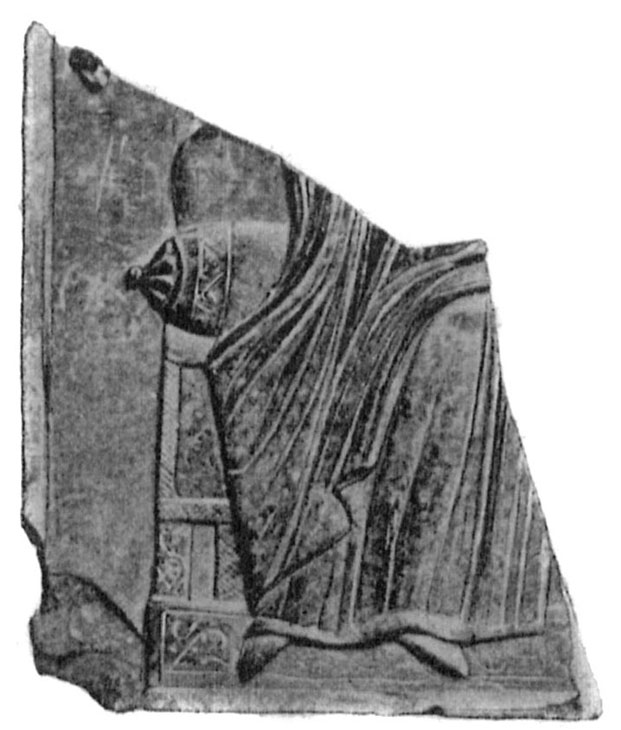
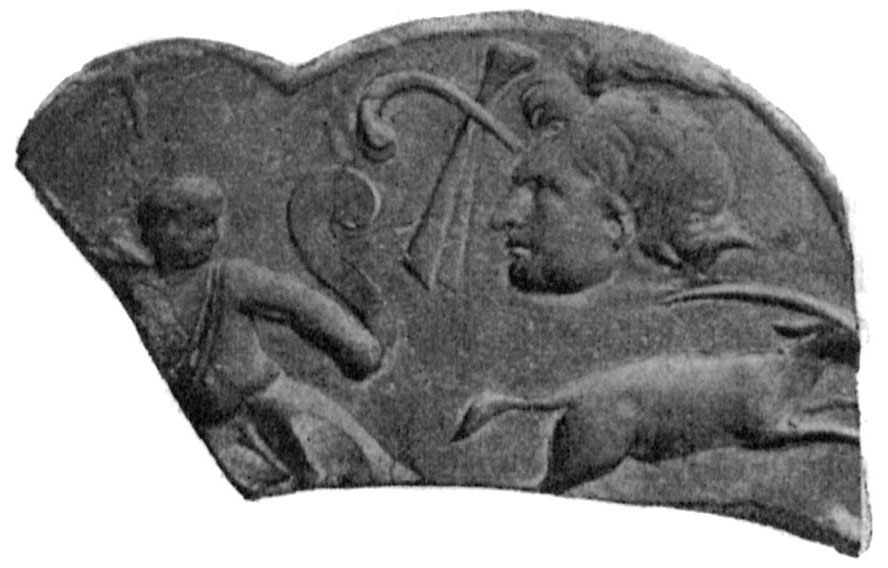
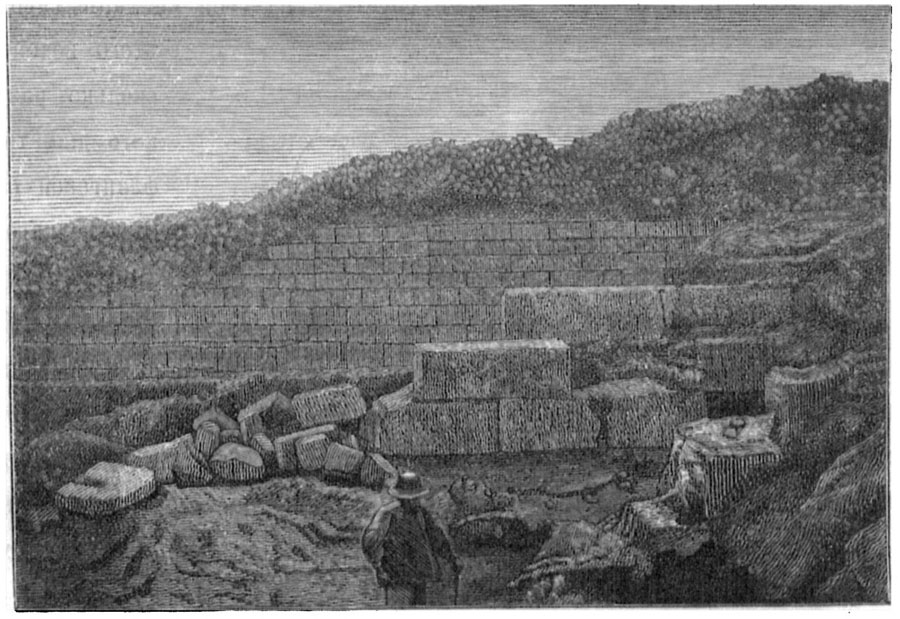
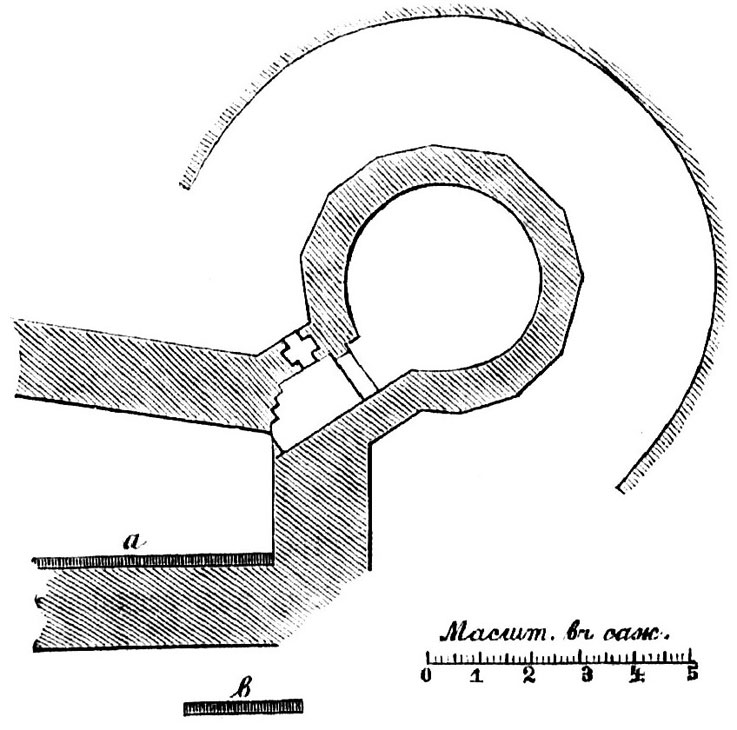
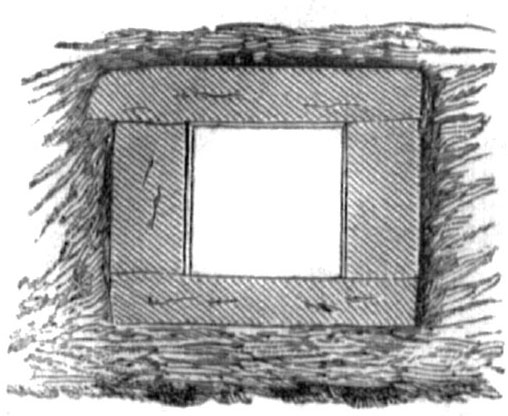
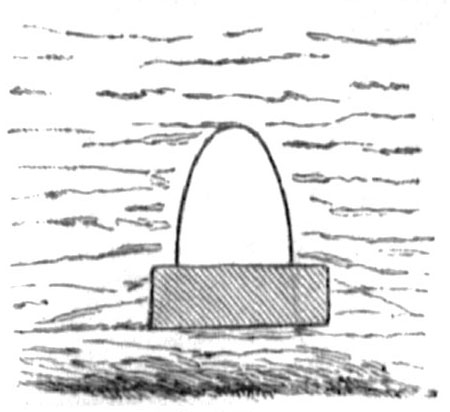
 scratched on it.
scratched on it.
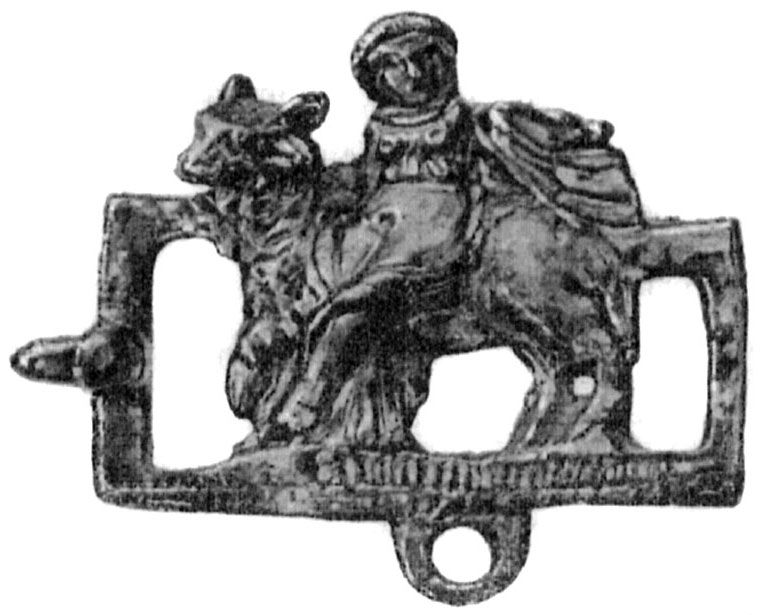
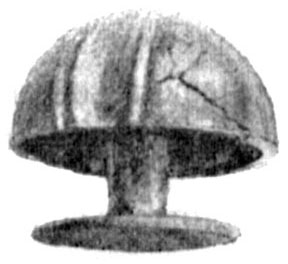
 . This tomb was covered with stone slab from above. The skeleton was placed with the head oriented to the east. The tomb was located in between of the flanking tower and counterscarp, 1 ½ arch<ine> far from the first one. It contained: black slip earthenware plate and lead ornaments of unknown purpose in the form of bunches of three narrow leaves as long as 2", with hook above (2 intact and 4 in pieces).
. This tomb was covered with stone slab from above. The skeleton was placed with the head oriented to the east. The tomb was located in between of the flanking tower and counterscarp, 1 ½ arch<ine> far from the first one. It contained: black slip earthenware plate and lead ornaments of unknown purpose in the form of bunches of three narrow leaves as long as 2", with hook above (2 intact and 4 in pieces).
 carved below than the neck. Apart from cremated bones, it contained piece of sheet gold and broken iron athlete's scraper.
carved below than the neck. Apart from cremated bones, it contained piece of sheet gold and broken iron athlete's scraper.

